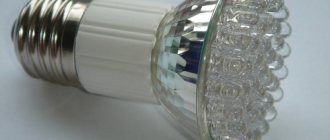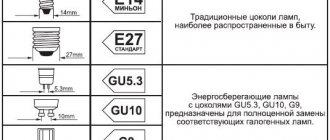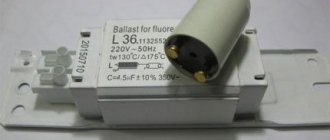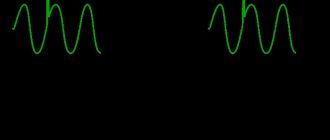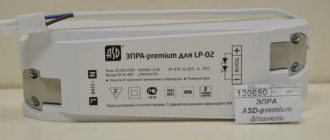A high-pressure mercury arc lamp is one of the types of electric lamps. It is widely used to illuminate large objects, such as factories, factories, warehouses and even streets. It has a high light output, but does not have a high degree of quality and the light transmission is quite low.
Such devices have a very wide power spectrum, from fifty to two thousand watts, and operate from a standard network of 220 volts, at a frequency of fifty hertz.
What is a DRL lamp
Appearance of DRL lamps
First of all, it is worth understanding the name, because it is by this name that the master determines the characteristics and working conditions. The abbreviation DRL can be deciphered as follows:
- D – ignition type. The source ignites under the influence of an electric arc, which is formed when voltage is applied.
- R – mercury.
- L - the conversion of ultraviolet glow into visible light is carried out using a phosphor.
Also in the marking after the letters you can see a digital three-digit code. It shows the power for which the lamp is designed. On sale you can find devices with a power of 150 W, 200 W, 250 W, 400 W and other load values. In everyday life, light bulbs of 250 W and 400 W are usually used.
Types of devices with DRL, their parameters and cost
For DRL devices, flashlights of two main types are produced, which best suit the scope of application.
Comparison of light sources.
Console
Everyone is familiar with teardrop-shaped lamps for poles, fixed at an angle of 15° relative to the horizontal. Designed for one or several (up to three) lamps, they have both built-in and external choke. The housing and reflector are made of special sheet steel. The lampshade can be equipped with a protective glass cap or a metal grille. Lamps used: 125, 250, 400 W. The price depends on the power. The cost of a 400 V DRL lamp starts from 2000 rubles. DRL cantilever luminaires are designed for high poles and illumination of large areas. Installation height from 3 to 5 meters.
Find out what street ground lamps are here.
Crowning (floor lamps)
Usually made in the form of a frosted or transparent ball of glass or polycarbonate, the base is a pillar, support or decorative cabinet. They also produce floor lamps in the shape of an inverted cone, in which the glass diffuser is complemented by a protective metal cap. The throttle is located at the base of the lampshade, lamp used: 125, 150 W. Installation height is from 3 to 5 meters.
DRL pole lamps are designed for high-rise lighting. Console lamps provide lateral, asymmetrical light, while floor lamps distribute lighting evenly. Cantilever ones are equipped with reflectors and cover a large area. A necessary element of street lighting will be a waterproof switch.
The specific cost of luminaires for DRL depends on the manufacturer and case materials; console models with protective glass and glass crowns are more expensive. On average, the price of a console lamp starts from 900 rubles; for the crowning variety made of polycarbonate you will have to pay at least 1,400 rubles. If you choose a glass floor lamp, prepare at least 2,500 rubles.
Design features and principle of operation
DRL lamp design
The DRL lamp has a standard design for gas-discharge lamps. It consists of three parts - a glass flask, a base and a burner. Inside the burner there are electrodes and a limiting resistor. The air in the flask is evacuated, after which it is filled with nitrogen. A phosphor is applied to the inner surface. The burner contains a mixture of inert gases and mercury. Bulb sockets are different, the standard is E14 and E27.
DRL lamps work similarly to gas discharge lamps. When voltage is applied to live parts, a glow discharge occurs. As a result, electrons and ions accumulate and the inside of the tube heats up. The mercury evaporates, the glow discharge becomes an arc. As the amount of mercury vapor increases, the brightness of the glow increases. The resulting ultraviolet light hits the phosphor. When passing through it, it is converted into visible radiation.
Subject to operating conditions, the time it takes to turn on the light bulb and reach the stated parameters is about 4 minutes. As the temperature rises, this time decreases.
Electromagnetic type ballast
For an electromagnetic ballast, its connection diagram is as follows:
Electromagnetic ballast connection
Here the inclusion process involves the following actions:
- at the moment of current flow, energy accumulation occurs in the inductor;
- then it goes to the starter connectors;
- the current is directed to the starter through the electrode heating filaments;
- the electrons and the starter itself heat up;
- then the bimetallic contacts on the starter open;
- opening of connectors is accompanied by the release of electricity accumulated in the ballast;
- The voltage in the electrodes changes, which leads to a glow.
This way the lamps will be activated when using the above connection option.
Types of DRL lamps
DRL 250 and DRL 400
lamps DRL lamps have several modifications that have different technical characteristics and operating conditions.
- Classic DRL lamp. Standard modification. The disadvantages of the model include high heating during operation, sensitivity to voltage changes, and a long time to reach optimal performance characteristics. The most common are DRL 250 lamp and DRL 400. The luminous flux of DRL 250 allows the device to be used in home lighting.
- DRV or DRVED – tungsten mercury arc (erythemal tungsten) lamp. The product starts without using a choke and has improved light emission performance.
- DRLF - unlike a standard lamp, it has improved characteristics due to the coating of the bulb with reflective material.
All of the listed types can replace each other.
Checking functionality
To check the performance of the DRL, testers (ohmmeters) are used, which is necessary if the lamp refuses to work or functions incorrectly. Connect the device to each turn on the winding, checking them for open circuit and short circuit current:
- If a break is detected, the device will show a huge resistance, so you will have to replace the winding.
- If there is no break and no loss of insulation is detected (thus creating a short circuit), the difference in resistance will be less significant.
- If there is a short circuit on the inductor winding, an increase in resistance may not be observed and the technical characteristics will remain the same. On the other hand, this fact does not in any way affect the performance of the lamp itself.
If the ohmmeter does not show any deviations, then the problem should be looked for in the lighting fixture or electrical network. The lamp may need repairs.
Specifications
Any lighting product must have information about power.
In DRL lamps it is indicated in the marking. Also important indicators are:
- Light flow. This value determines how many light bulbs are needed to create the required level of illumination per unit area. DRL 400 has a luminous flux of 18,000 lm.
- Approximate operating time. Shows how many hours the light bulb can work under the stated conditions.
- Base. Sets parameters for a chandelier or other lamp.
- Dimensions.
- Supply voltage.
All these parameters, as well as operating conditions, can be found in the documentation for the lamp.
Design
DRL lamp design
The DRL lamp consists of the following elements:
- Main electrodes.
- Ignition electrodes.
- Electrode inputs.
- Reserve gas.
- Posistor.
- Mercury.
When DRL lamps first began to be manufactured, their circuit included only a pair of electrodes. To connect it, a source of high-voltage pulses was needed, which had a very short operating duration. The level of knowledge in the electrical field at that time did not allow the creation of high-quality ignition devices, so their production stopped in the 70s of the last century. Now there are lamps with two pairs of electrodes, which do not require PAs to turn on.
A mercury arc lamp contains the following functional elements:
- Base with thread. Receives electricity from a source through threaded and point contacts. After this, electrical pulses are transmitted to the burner electrodes.
- A quartz mercury burner is the main component, filled with a pair of key and a pair of auxiliary electrodes. It is filled with argon and mercury, due to which heat exchange occurs inside the DRL lamp.
- A glass cylinder is an external part with a quartz burner with conductors inside. The cylinder device is filled with nitrogen. It also contains a pair of limiting resistances and is coated with phosphor on the inside.
Application area
DRL lighting devices are actively used as a source of artificial light in external and internal lighting: for illuminating roadways, highways, parks and squares, as well as production facilities and industrial workshops with a power of several megawatts.
DVR products are used in the same facilities as DRL, as well as in lighting agricultural enterprises that grow various crops in insulated soil. These can be greenhouses, greenhouses, gardens.
What is a throttle for?
The choke for DRL lamps is used for starting; there are different types of lighting devices on the market in which it is used:
- Fluorescent and ultraviolet lamps.
Ultraviolet lamp Various types of mercury arc lighting devices: DRT, DRL, DRIZ, DRSh, DRI.
Arc mercury lamps Arc sodium lamps: DNaMT, DNaS, DNaT. Arc sodium lamp
All lighting devices have differences in the principle of obtaining light flux, there are other differences:
- different materials are used in their design;
- differ in the presence of chemical elements;
- inside the flasks there is pressure according to the own parameters of each lighting device;
- they differ in power and brightness of the light flux.
These types of lamps are united by the variable value of the starting current and resistance during the start-up process and further operation.
In order to limit the amount of operating current, different types of ballast are used in lighting devices of this type: electronic ballasts, ballasts and ballasts, which are inductor coils (chokes). At the moment of startup, each device of this type has a high resistance value; when the lighting device is ignited, a process of electrical breakdown occurs in the inert gas environment with which the lamp is filled (mercury or sodium vapor), and an arc discharge occurs.
During the process when the lamp is ignited, the ionized gas loses resistance from the arc discharge several tens of times, and for this reason the current increases and heat is released. If you do not limit the amount of current, it will instantly create a superheated gas environment, which will lead to breakdown of the lighting device and damage from the inside. To prevent this, a resistance (choke) is included in the lighting device circuit.
Physical parameters and connection diagram of the inductor
A DRL inductor connected in series has a reactance, the value of which depends on the inductor: one Henry passes one ampere of current when the voltage is one volt.
Throttle
The parameters of the inductor include:
- square of copper wire used;
- number of turns;
- what is the core and cross-sectional size of the magnetic circuit;
- what electromagnetic saturation.
The inductor has an active resistance, which is always taken into account when calculating the ballast for each type of lighting device of this type, taking into account its power; the overall dimensions of the inductor depend on this.
Let's consider a simple circuit for switching on the ballast, when the design of the DRL lamp provides (additional) electrodes for the process of occurrence of a glow discharge that turns into an electric arc.
DRL lamp connection diagram
In this case, inductance limits the amount of operating current in the lighting device.
Ballast for fluorescent lamps
Structurally, a fluorescent lighting device uses a ballast choke for starting; new types of this lighting device use electronic ballasts, this is an electronic type of ballast. The purpose of this device is to contain the increasing current value at one level, which maintains the required voltage on the electrodes inside the lighting fixture.
Connecting the lamp
The DRV modification does not require a choke for connection. The light bulb can be directly connected to the mains. The throttle lamp connection diagram requires a ballast. This device provides regulation of the current within specified limits. Using a choke, you can prevent the light source from burning out and create a mode for starting it. The inductor also corrects the operation of the device by stabilizing the operating voltage supplied to the contacts.
There are two types of chokes - independent and built-in. They are installed in various luminaire designs and depend on the installation location of the ballast (ballast).
The choice of ballast model is influenced by the following parameters:
- electric power of a light bulb;
- operating current and voltage;
- winding temperature;
- maximum permissible heating;
- greatest power loss;
- Power factor.
The most common breakdown in gas-discharge DRL lamps is associated with problems with the ballasts. The device will not light up during operation. For this reason, it is important to be able to check the throttle for functionality. This can be done using a multimeter, which will check the integrity of the windings and the presence of an interturn short circuit.
Another way to check is with an incandescent lamp of the same power connected in series to the circuit. If the product is in good working order, the light will turn on at half power or flash. If there is no light, you can judge that the winding is damaged. Too bright a light indicates the presence of an interturn short circuit.
Selection rules
To choose the right starting inductance, you need to pay attention to the device body. It indicates the load power that it can power. The power of the ballast depends on the cross-section of the winding wire: the larger it is, the more significant current the device can produce.
Powerful coils have significant dimensions and a higher cost, so it is necessary to optimally select the starting inductance. You can use one coil to power several lamps - this is often done in double lamps, which can often be found in office spaces.
Throttle Starter
Advantages and disadvantages
The advantages of the lamp include standard sockets.
DRL lamps are quite popular light sources. This is due to their positive qualities, which include:
- long service life;
- compactness;
- standard plinths;
- good luminous flux;
- reduced energy consumption.
Disadvantages limiting the use of light bulbs:
- Susceptibility to voltage changes.
- The presence of pulsations that are harmful to human health.
- Long ignition time.
- The presence of harmful ultraviolet light.
- Lamp modifications have lower efficiency and service life.
- The presence of harmful components in the composition.
- Fragility. The glass flask is easy to break, so you need to work with the device carefully.
- Difficulty in recycling. Mercury and other harmful substances contained in the device mean that the light bulb should not be thrown away with household waste. It is disposed of at special collection points.
Despite all the advantages of such light sources, most electricity consumers switch to LED analogues. They are safer, have a longer service life and improved performance. The LED lamp E40, an analogue of the DRL 400, has already practically replaced the gas-discharge product.
In 2014, the Russian Federation signed the Minamata Convention. According to this document, starting from 2022, the production, use, export and import of mercury products must be stopped. Gas-discharge devices are prohibited, so it is now recommended to think about replacing DRL 400 with LED lamps with improved characteristics and a high degree of environmental friendliness. This applies to both home and industrial and street lamps.
Disposal
The lighting devices in question are classified as hazard class 1. Therefore, the number of places where these are prohibited for use is now growing. It is possible that in a few years mercury lamps will be phased out everywhere, as government policies are aimed at reducing the amount of equipment containing mercury. In compliance with government orders, utilities are reducing their use of DRLs.
Unfortunately, not everyone thinks about the issues of decommissioning such light sources. By doing this, they harm not only themselves, but also those around them.
Soon their sale will be completely stopped. Devices containing mercury will be left only in medical equipment until a safe analogue is found.
Currently, recycling of mercury lamps is a licensed service. On September 3, 2010, a corresponding decree of the Russian government was adopted. The document describes the requirements for the disposal process and contains information on the procedure for dealing with mercury contamination. The process of demercurization - removal of mercury is described.
Now all legal entities of the Russian Federation are required to create a waste passport for fluorescent lamps and keep strict records of mercury-containing waste. The presence of mercury is already a potential danger.
Recycling and recycling refers to the recovery of used metals from devices containing them. Including mercury. A damaged flask will allow liquid metal to escape into the environment.
In Russia, the Federal Law No. 187 is in force (Article 139). According to it, a fine will be collected for improper disposal or placement of a hazardous waste container in an inappropriate place. Unauthorized removal from the storage area is also punishable.



